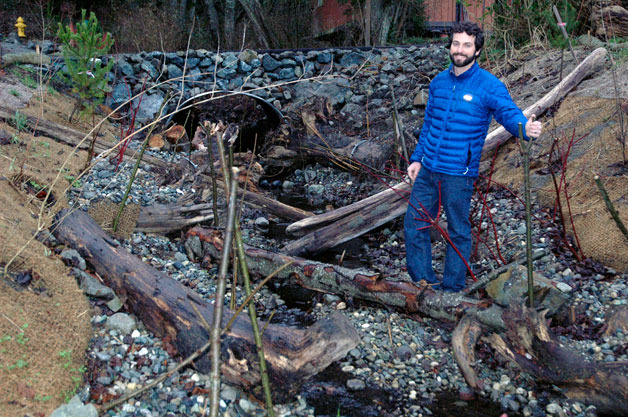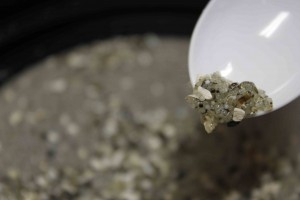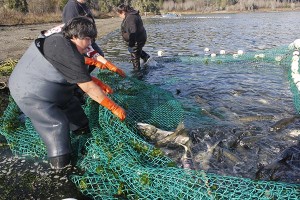
— image credit: Kirk Boxleitner
By Janelle Kohnert, Marysville Globe
SMOKEY POINT — Arlington Police Officer Erik Moon has taken part in three of the annual “Night of 1,000 Stars” impaired driving emphasis patrols in Snohomish County over the course of the past seven years. When he headed out to cover the south Arlington, Smokey Point and north Marysville areas on the evening of Dec. 13, he already had a pretty good idea of what he could expect to find, although he acknowledged that this year would offer a few new wrinkles.
“The holidays can be depressing for some people, so they drink a bit too much,” Moon said. “What’s different now is that people can smoke marijuana in their homes, but then they might decide to go for a drive to the store. It’s not alcohol, but it’s still driving under the influence. We have to administer a blood draw to test for that, since you can be high on marijuana and blow all zeros on the breathalyzer, so that does no good as a test. Still, it’s like the adjustments we went through when they lowered the blood alcohol limit a while back. It’s just another learning curve.”
According to Moon, those who drive under the influence tend to be in their 20s and 30s, although he recalled one intoxicated driver who was 87 years old.
“It caught me off guard a little bit, but I processed her the same as I would any other DUI,” Moon said. “We can’t be choosy when it comes to protecting the public.”
Moon was one of 10 police officers and sheriff’s deputies in Snohomish County, working an average of eight hours of overtime each, who made contact with 167 drivers on Friday, Dec. 13, the first night of Washington state’s 23rd annual “Night of 1,000 Stars,” which ran through Sunday, Dec. 15.
“Five suspected impaired drivers were arrested,” Snohomish County DUI and Target Zero Task Force Manager Tracy McMillan said. “Most were booked into the Snohomish County Jail. Two of the suspected drivers reported drinking at a north Marysville alcohol establishment, which Washington State Liquor Control Board officers are investigating, while 24 other drivers were cited for no insurance, and four individuals were arrested for outstanding warrants. Washington State Liquor Enforcement officers visited 14 alcohol establishments that Friday night, and 20 alcohol establishments and retailers that Saturday night. Unfortunately, two stores sold alcohol to minors and were cited.”
Indeed, in his first hour on patrol that Friday night, Moon hadn’t caught any intoxicated drivers, but he had pulled over two drivers whose headlights were out within minutes of each other.
“Intoxicated drivers like to drive without their lights on,” Moon said. “I look at a lot of things for possible indicators of a DUI. Some intoxicated drivers will sit at green lights because they’re nearly passed out, while others will make wide turns or slow turns. They could be intoxicated, or they could be distracted by things like texting, but either way, they’re unsafe. Intoxicated drivers’ cognitive functions are not all there, and if they do get into collisions, they’re actually the least likely to be injured by them, because their muscles are already relaxed.”
Even after the “Night of 1,000 Stars,” extra patrols are planned to continue through the New Year.
“Officers, deputies and troopers will also be on the lookout for people who speed, drive aggressively, aren’t wearing seat-belts or are violating other traffic laws,” McMillan said. “Wintertime driving can be hazardous, but it can be deadly when it’s mixed with alcohol or drugs.”
“Impaired driving as the result of drugs or alcohol is the number one cause of vehicle collision deaths in our county,” Snohomish County Sheriff Ty Trenary said. “We want to everyone to make it home safely this holiday season.”
An average of 49 people lose their lives in traffic collisions between Thanksgiving and New Year’s Day in Washington state, but in November of this year, not a single person lost their life in a motor vehicle collision in Snohomish County.
“That’s a tremendous accomplishment, but we need to remain vigilant,” Snohomish County Executive John Lovick said. “We want drivers to be safe throughout the holidays.”
These special overtime DUI and Target Zero emphasis patrols are paid for by a special grant from the Washington Traffic Safety Commission to reduce traffic deaths and disabling injuries to zero by the year 2030. The “Night of 1,000 Stars” is a cooperative effort with law enforcement, liquor enforcement and traffic safety task forces throughout Washington state.




















